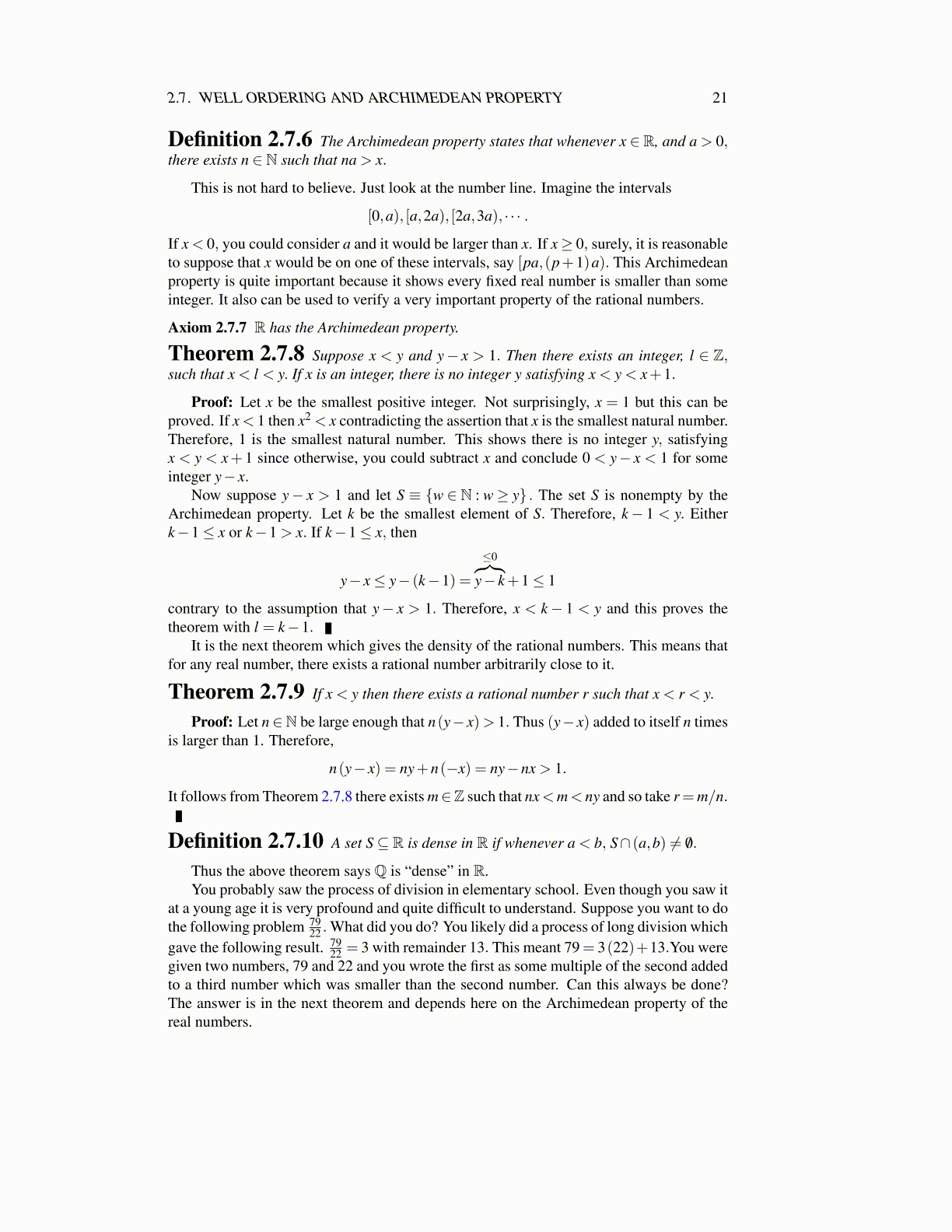
2.7. WELL ORDERING AND ARCHIMEDEAN PROPERTY 21
Axiom 2.7.7 R has the Archimedean property.
Theorem 2.7.8 Suppose x < y and y− x > 1. Then there exists an integer, l ∈ Z,such that x < l < y. If x is an integer, there is no integer y satisfying x < y < x+1.
Proof: Let x be the smallest positive integer. Not surprisingly, x = 1 but this can beproved. If x< 1 then x2 < x contradicting the assertion that x is the smallest natural number.Therefore, 1 is the smallest natural number. This shows there is no integer y, satisfyingx < y < x+ 1 since otherwise, you could subtract x and conclude 0 < y− x < 1 for someinteger y− x.
Now suppose y− x > 1 and let S ≡ {w ∈ N : w≥ y} . The set S is nonempty by theArchimedean property. Let k be the smallest element of S. Therefore, k− 1 < y. Eitherk−1≤ x or k−1 > x. If k−1≤ x, then
y− x≤ y− (k−1) =
≤0︷︸︸︷y− k+1≤ 1
contrary to the assumption that y− x > 1. Therefore, x < k− 1 < y and this proves thetheorem with l = k−1.
It is the next theorem which gives the density of the rational numbers. This means thatfor any real number, there exists a rational number arbitrarily close to it.
Theorem 2.7.9 If x < y then there exists a rational number r such that x < r < y.
Proof: Let n∈N be large enough that n(y− x)> 1. Thus (y− x) added to itself n timesis larger than 1. Therefore, n(y− x) = ny+n(−x) = ny−nx > 1. It follows from Theorem2.7.8 there exists m ∈ Z such that nx < m < ny and so take r = m/n.
Definition 2.7.10 A set S⊆ R is dense in R if whenever a < b, S∩ (a,b) ̸= /0.
Thus the above theorem says Q is “dense” in R.You probably saw the process of division in elementary school. Even though you saw it
at a young age it is very profound and quite difficult to understand. Suppose you want to dothe following problem 79
22 . What did you do? You likely did a process of long division whichgave the following result. 79
22 = 3 with remainder 13. This meant 79= 3(22)+13.You weregiven two numbers, 79 and 22 and you wrote the first as some multiple of the second addedto a third number which was smaller than the second number. Can this always be done?The answer is in the next theorem and depends here on the Archimedean property of thereal numbers.
Theorem 2.7.11 Suppose 0 < a and let b≥ 0. Then there exists a unique integer pand real number r such that 0≤ r < a and b = pa+ r.
Proof: Let S ≡ {n ∈ N : an > b} . By the Archimedean property this set is nonempty.Let p+ 1 be the smallest element of S. Then pa ≤ b because p+ 1 is the smallest in S.Therefore, r ≡ b− pa ≥ 0. If r ≥ a then b− pa ≥ a and so b ≥ (p+1)a contradictingp+1 ∈ S. Therefore, r < a as desired.
To verify uniqueness of p and r, suppose pi and ri, i = 1,2, both work and r2 > r1.Then a little algebra shows p1− p2 =
r2−r1a ∈ (0,1) . Thus p1− p2 is an integer between 0
and 1, contradicting Theorem 2.7.8. The case that r1 > r2 cannot occur either by similarreasoning. Thus r1 = r2 and it follows that p1 = p2.
This theorem is called the Euclidean algorithm when a and b are integers. In this case,you would have r is an integer because it equals an integer.